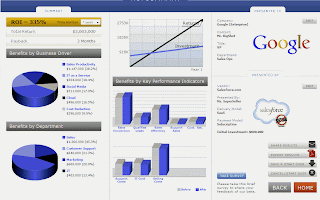For those of us who sell complex technology solutions to the enterprise, why do we allow prospects to basically make this ultimatum, “Your solution better give me a one year or better payback or I don’t even want to talk to you?” This is obviously not always the case, but it sure happens a lot.
Take recent stock market turbulence aside for a second and ask yourself what kind of “payback” or ROI you expect from the personal financial investments you make, such as stocks in your IRA or 401K, over the long term?
5%, 8%, 11%? I can assure you that if you went to just about any financial planner and told them you want a portfolio that consistently delivered 11% (let alone 100%) annual returns, with low risk, they’d give you a funny look before aggressively working to reset your expectations. They’d probably show you historical averages and explain how – over the long term – a low risk 7-8% yearly return on investment, with a mixed set of assets is a “fair,” even slightly aggressive goal. What’s known as the Rule of 72, a simple way to calculate payback, tells us an investment with a 7% return will take over 10 years to fully payback.
Houston, we have a problem. 10 years vs 1? Why the major disconnect between these two cases?
Anyone with a rudimentary understanding of investing will tell you there is usually a strong relationship between risk and return. If you’re willing to take enough risk you can reasonably expect the possibility of very large returns, but along with that comes the possibly of significant losses. While lower risks usually mean lower returns.
So, our prospects are telling us – even if they won’t or can’t articulate it – that they see giant risk associated with buying and implementing our solutions. And what’s interesting is that this really doesn’t change even after all those tests, and pilots, free trials, time, reference calls, and other “proof.” You ever heard a prospect say, “you know, after the success of this pilot, I’m going to tell my boss we just need a five year payback instead of one”? I don’t think so.
If we get a little mathematical here, we have 3 variables at work:
- Cost of Solution and implementation
- Risk
- Return (or ROI)
Essentially, our prospects have jacked up our costs (damn them!) on the calculation of a reasonable return by adding a big helping or risk, which is a form of cost. So we have these three things we can try to influence when we sell.
The Cost: This one’s been covered about a billion times, but it’s fairly safe to say that selling via cost or discounting is neither effective nor lucrative. But even from a pure calculation perspective, because customers are basically making Risk the dominant component of cost, changing your price actually doesn’t help much when ROI is an important consideration in a complex sale. I’ll save you a discussion of denominators and numerators, or customer’s “hurdle rate” or IRR, but suffice it to say that the math alone tells us a focus on our cost is a mistake.
The Risk: We already explained that it very difficult, in a one-off sales campaign, to reset the perception of risk. This is not only something that takes time to evolve for a company (more mature solutions will naturally be perceived as less risky), but really the whole industry of buying and selling complex solutions to the enterprise. Like price, one can impact the “cost” associated with risk, but not in a meaningful way. Some of the risk, say with deployment or integration, is honestly out of our control. In other words, yes, make sure your prospect understands your solution works, but don’t waste tons of time trying to convince them there’s no risk. It won’t pay off.
The Return: Ah, the value. Think of it this way, if the return (value) is big enough - and of course believable enough, you can reach a point where the cost (and risk) doesn’t even matter that much. Is that the final destination for most of our sales opportunities? Probably not. But that should be our goal. Maximum believable value. It would also be good if that value was differentiated – unique if possible, and even surprising in some way (as advocated in the resent book, The Challenger Sale)
Yes, I’m certain there are industries where the expectation of payback isn’t one year. There are more mature markets where actual costs do matter a lot, and where the ability to show meaningful lower risk is possible.
But the best return on your time is to maximize value – and make sure that value is believable. Show all the places you reduce cost or help drive revenue. All the KPIs you influence. All the business drivers – initiatives and challenges - you impact. Build a ROI that quantifies and aligns your value. Do it early in the sales process, too. You’ll win more deals. And make more money.

